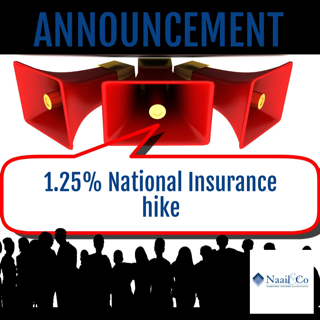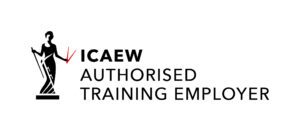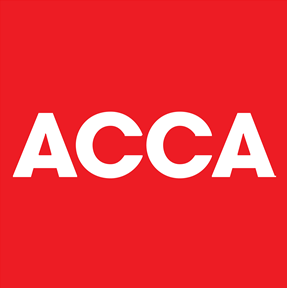1.25% National Insurance hike
Table of Contents
PM announces 1.25% National Insurance hike
Key Points
- PM unveils £12bn-a-year tax rise to pay for NHS and social care
- From April 2022, national insurance contributions rates and taxes on dividends will go up by 1.25% percentage point
- Employers will also need to contribute an additional 1.25% (employer national insurance is currently 13.8%)
National Insurance contributions will rise by 1.25% percentage points to pay for the social care system in England, with the levy expected to raise about £12bn.
This includes £2.2 billion a year for Scotland, Wales and Northern Ireland, as tax changes affect the whole of the UK.
Prime Minister Boris Johnson said the costs of the programme will be split between individuals and businesses and ‘those who earn more will pay more’.
How is it funded?
A new UK-wide 1.25% “health and social care levy” will come in from April 2022, based on national insurance contributions. It will be paid by working adults, including people over the state pension age (unlike normal national insurance, which is not paid by pensioners).
Initially from April 2022 national insurance contributions rates will go up by 1.25% percentage points while taxes on dividends will also increase by 1.25% to ensure the selfemployed do not try and avoid the new levy.
But from April 2023, once tax systems have been updated, the levy will be separated, so that the levy will appear as a separate line on pay slips. At this point working adults above state pension age will start contributing.
Big businesses will pay the most of the extra revenue coming from the increase to employers NICs, with 70% of the money coming from the biggest 1 % of employers – those with more than 250 employees.
40% of all businesses (mostly small business) will not have to pay anything extra. New levy will “share the costs” between individuals and businesses
Speaking in the House of Commons, Johnson said: ‘Some will ask why we don’t increase income tax or capital gains tax instead, but income tax isn’t paid by businesses so the whole burden would fall on individuals – roughly doubling the amount the total taxpayer is expected to pay.
The total revenue from capital gains tax is £9bn this year – our new levy will share the costs between individuals and businesses and everyone will contribute according to their needs.’
From October 2023, people with assets of between £20,000 and £100,000 will still contribute to their adult care costs, while people with assets of under £20,000 will not pay for any of their care costs. The maximum cap on individual costs will be £86,000
How much more you’ll be paying?
The rates on “class one” contributions which employees pay on earnings in excess £9,568 a year will rise to 13.25% from 12%, while the ”upper earnings rate” which kicks in on earnings of more than £50,270 a year will increase to 3.25%, from 2%.
The self-employed pay slightly lower rate “class four” contributions. The rate they pay will rise to 10.25%, from 9% on annual earnings of more than £9,568 and at 3.25% on anything more than £50,270, up from 2%.
Some lower-earning freelancers pay “class two” NI annual earnings of £6,515 up to the class four threshold, at a rate of £3.05 a week.
The rate on employer contributions paid by companies will rise to 15.05%, up from 13.8%.
How National Insurance contributions will change with a 1.25% increase?
Pay Example | Current Contribution | New Contribution |
£10,000 salary | £52 paid now | £57 with 1.25% increase – £5 extra each year |
£20,000 salary | £1,252 paid now | £1,382 with 1.25% increase -£130 extra each year |
£30,000 salary | £2,452 paid now | £2,707 with 1.25% increase- £255 extra each year
|
£40,000 salary | £3,652 paid now | £4,032 with 1.25% increase -£380 extra each year |
£50,000 salary | £4,852 paid now | £5,357 with 1.25% increase -£505 extra each year |
£75,000 salary | £5,379 paid now | £6,197 with 1.25% increase -£818 extra each year |
£100,000 salary | £5,879 paid now | £7,009 with 1.25% increase -£1,130 extra each year |
National Insurance: Behind the figures
Under the current system, you pay 12% on your earnings between £9,568 and £50,270, and 2% on any income above £50,270.
A typical basic rate taxpayer earning £24,100 will pay £180 a year, or £3.46 per week. A typical higher rate taxpayer earning £67,100 – in the top 15% of earners – will pay £7.15 a week.
Additional rate taxpayers (those paying the highest rate) will contribute 20% of the revenue, even though they are just 2% of taxpayers. Higher rate taxpayers – 14% of the total – will pay half the revenue.
6.2 million people earning less than £9,568 will not have to pay.
You pay National Insurance contributions to qualify for certain benefits and the State Pension. You pay mandatory National Insurance if you’re 16 or over and are either:
- An employee earning above £184 a week
- Self-employed and making a profit of
£6,515 or more a year
You may be able to pay voluntary contributions to avoid gaps in your NI contributions. You need a National Insurance number before you can start paying National Insurance contributions.
If you earn between £120 and £184 a week, your contributions are treated as having been paid to protect your National Insurance record. If you’re employed, you stop paying Class 1 National Insurance when you reach the State Pension age.
If you’re self-employed you stop paying:
- Class 2 National Insurance when you reach State Pension age
- Class 4 National Insurance from April 6
(start of the tax year) after you reach State Pension age
What happens in the rest of the UK?
The Westminster government only controls the situation in England. In Wales, no-one who is eligible for care at home is expected to pay more than £100 a week.
The systems in Northern Ireland and Scotland are different for support at home and residential care.
In Northern Ireland, no-one over the age of 75 pays for home care.
Scotland provides free personal care for people who are assessed as needing support at home, whatever their age. In Scottish care homes, people get free care if they have savings or assets of less than £18,000.
Those with savings and assets of between £18,000 and £28,750 have to fund part of their care. People with more than that have to fund their own care, apart from a £193.50 a week contribution towards personal care and £87 .10 a week towards nursing care.
How to cut your National Insurance bill?
If your company offers a salary sacrifice scheme for pension contributions, then you can slash your National Insurance bill by paying more into your pension.
A salary sacrifice scheme is where you give up a portion of your salary in exchange for a noncash benefit – such as pension contributions.

Our service to you
If you are a self employed, business owner/director of company looking to get your accountancy and taxation matters sorted, look no further. We, at Naail & Co, are pro-active and easily accessible accountants and tax advisors, who will not only ensure that all your filing obligations are up to date with Companies House and HMRC, but also you do not pay a penny more in taxes than you have to. We work on a fixed fee basis and provide same day response to all your phone and email enquiries. We will also allocate a designated accounts manager who would have better understanding of your and business financial and taxation affairs. Book a free consultation call using the link below.
Related Blogs:
Get further information from the following blogs;
PAYE will be payable by direct debit to HMRC
PAYE tax avoidance promoters – Named & shamed
NI Threshold changes from 6 July 2022
Statutory sick pay rebate scheme reinstated
Covid support measures come to an end
Businesses pay back £1.3 billion of furlough
Tax free earnings for teenagers capped at £1,000
Employers named and shamed for paying less than minimum wage
Don’t get caught by 60% income tax rate
HMRC targets self employed who overclaimed grants
Late tax payment interest rate raised to 2.75%
Covid grants to be included in tax returns
Subscribe to our newsletter
BUSINESS HOURS
Monday – Friday
- 9:00 am – 5:30 pm
Pages:
Menu








